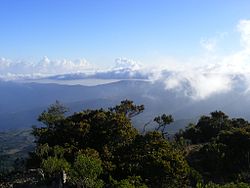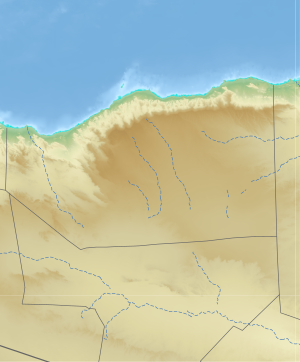Sanaag
Sanag
| |
|---|---|
 Overview of theCal Madowmountains in Sanaag | |
 Location in Somaliland | |
| Coordinates:10°46′45″N48°11′9″E/ 10.77917°N 48.18583°E | |
| Country | |
| Administrative centre | Erigavo |
| Government | |
| •Governor | Mahamed Elmi Hussein Ahmed[1] |
| Area | |
| • Total | 54,231 km2(20,939 sq mi) |
| Population (2022[2]: 172 ) | |
| • Total | 325,136 |
| IPC document listed number | |
| Time zone | UTC+3(EAT) |
| HDI(2021) | 0.448[3] low·3rd of 18 |
Sanag(Somali:Sanaag,Arabic:سَنَاج) is an administrative region (gobol) in north easternSomaliland.[4]Sanaag has a long coastline facing theGulf of Adento the north, and is bordered by the region ofSahilto the west,Soolto the south andSomaliato the east. The region is disputed by the self-declared Republic ofSomalilandandPuntland,a Federal Member State ofSomalia.[5][6][7][8][9][10]Its capital city isErigavo.Sanaag is the largest region of Somaliland, accounting for 35% of Somaliland's total land area.[11]
The region is partially controlled byPuntlandand Somaliland.[12][13]Puntland disputes theHartiinhabited parts of region as being part of Somaliland while the latter claims the entire region based on theBritish Somalilandboundaries.
Territorial dispute

The Sanaag region is disputed between Somaliland andPuntland.Somaliland effectively controls the western and central parts of Sanaag. Puntland has effective control overBadhanand other areas in the east.[12]Somaliland has declared its claim to all of Sanaag, but some areas (that it struggles to control) do not actually participate in Somaliland's elections.[14]
History

From 1944 to 1974, modern-day Sanaag region was one of three districts of the Burao region. The other two districts were Burao and Las Anod.[15][16]Sanaag was carved out ofTogdheerregion and was established as a separate region on June 23, 1973, comprising the three districts ofErigavo,Las QoreyandGaradag.[17]
Sanaag is home to numerousarchaeological sites,with rock art, ancient ruins, buildings andcairnsfound at numerous sites, such asGudmo Biyo Cas,Heis,Maydh,Haylan,Qa'ableh,Qombo'ul,GelweitaandEl Ayo.[18]However, many of these old structures have yet to be properly explored, a process which would help shed further light on local history and facilitate their preservation for posterity.[19]
Sanaag is also home to the ruined Islamic city ofMadunanearEl Afweyn,which is considered the most substantial and most accessible ruin of its type in Somaliland.[20][21]The main feature of the ruined city includes a large rectangular mosque, its 3 metre high walls still standing and which include a mihrab and possibly several smaller arched niches.[21]Swedish-Somali archaeologistSada Miredates the ruined city to the 15th–17th centuries.[22]
Environment
A severedroughtin the region in the early part of the 21st century caused an 80% or greater loss of livestock, though two goodrainy seasonsin 2004–2005 helped restore the area. Over a 15-year period of analysis, from 1988 to 2003, there was a 52% loss offorestand a 40% loss ofgrassland,and a 370% increase in bare land. Soilerosiondue toweatherand human activities and clearing of wood and brush for such uses ascharcoaland fuel are issues leading to a degradation of the environment.[23]
Economy
In recent history, the Sanaag region normally maintained a diverse economy, producing and then exporting to other regions, it producedlivestock,frankincense,and leather for export, this was happening while the region lacked basicinfrastructure,but sadly, after the outbreak of civil war the region's economy collapsed from loss of markets and dilapidatedinfrastructurehas never helped, and lack of investment. Now the region only supports one main economy,livestockrearing. The Somali livestock ban imposed by Gulf countries in which was Sanaag's largest market has virtually destroyed the economy in the region, reducing purchasing power and forcing pastoralists in the region to survive on subsistence activities.[24]
Demographics
The region is mainly inhabited by people from theSomaliethnic group, principally theHabr YunisandHabar Jeclosub-clans of theIsaaqand theDhulbahanteandWarsangalisub-divisions of theHartiDarod.[25]
Districts
The region of Sanag is divided into 5 districts as follows:[26][27][28][29]
Towns and Cities
- Erigavo
- El Afweyne
- Maydh
- Badhan
- Dararweyne
- Las Khorey
- Garadag
- Heis
- Midhisho
- Yubbe
- Hadaaftimo
- Hingalol
- Dhahar
- Buraan
- El Buh
- Gudmo Biyo Cas
- Ruguda
- Yufle
- Dayaha
- Guud Caanood
See also
References
- ^"Somaliland: President Bihi Announces Government Reshuffle".11 September 2021.Archivedfrom the original on 26 January 2023.Retrieved22 November2021.
- ^euaa (2023)."Somalia: Security Situation"(PDF).Archived(PDF)from the original on 2023-07-04.Retrieved2023-12-09.
- ^"Sub-national HDI - Area Database - Global Data Lab".hdi.globaldatalab.org.Archivedfrom the original on 2018-09-23.Retrieved2018-09-13.
- ^Regions of SomaliaArchivedOctober 23, 2016, at theWayback Machine
- ^"Completed Project".www.eth.mpg.de.Archivedfrom the original on 2023-10-12.Retrieved2022-03-19.
- ^"Are Somaliland, Puntland ready for war over land?".The East African.2020-07-06.Archivedfrom the original on 2023-10-12.Retrieved2022-03-19.
- ^"Somalia: No elections in disputed regions, Puntland says - Somalia".ReliefWeb.Archivedfrom the original on 2022-03-19.Retrieved2022-03-19.
- ^"Averting War in Northern Somalia".Crisis Group.2018-06-27.Archivedfrom the original on 2023-01-26.Retrieved2022-03-19.
- ^Mahmood, Omar S. (2019-11-01)."Overlapping Claims by Somaliland and Puntland: The Case of Sool and Sanaag".Africa Portal.Archivedfrom the original on 2021-06-14.Retrieved2022-03-19.
- ^ISSAfrica.org (2019-12-09)."The various layers to the Somaliland-Puntland discord".ISS Africa.Archivedfrom the original on 2023-02-21.Retrieved2022-03-19.
- ^"Sanaag region nutrition survey report"(PDF).UNICEF:6. September 2002. Archived fromthe original(PDF)on 2021-07-11.Retrieved2021-12-11.
- ^ab"The Puntland Speaker visiting Badhan district".Somali Dispatch. 2021.Archivedfrom the original on 28 May 2023.Retrieved14 June2021.
- ^Mahmood, Omar (2019)."Overlapping claims by Somaliland and Puntland: The case of Sool and Sanaag"(PDF).Institute for Security Studies:13.Archived(PDF)from the original on 6 June 2023.Retrieved29 May2021.
- ^Mahmood, Omar (2019)."Overlapping claims by Somaliland and Puntland: The case of Sool and Sanaag"(PDF).Institute for Security Studies:13.Archived(PDF)from the original on 6 June 2023.Retrieved29 May2021.
- ^"Somalia (1988)".CIA.December 1988.Archivedfrom the original on 1 April 2016.Retrieved21 February2007.
- ^"Development map, roads, 1944".Library of Congress.Archivedfrom the original on 2023-10-12.Retrieved2022-03-17.
- ^"Faafin rasmi ah ee Jumhuriyadda Dimuqradika Somaliya | CRL Digital Delivery System".ddsnext.crl.edu.Archivedfrom the original on 2023-01-26.Retrieved2022-04-02.
- ^Mire, Sada (2015-04-14)."Mapping the Archaeology of Somaliland: Religion, Art, Script, Time, Urbanism, Trade and Empire".African Archaeological Review.32(1): 111–136.doi:10.1007/s10437-015-9184-9.ISSN0263-0338.
- ^Michael Hodd,East African Handbook,(Trade & Travel Publications: 1994), p.640.
- ^Dev, Bradt Guides."Maduna ruins".Bradt Guides.Archived fromthe originalon 2022-03-04.Retrieved2022-03-04.
- ^abBriggs, Philip (2012).Somaliland: with Addis Ababa & Eastern Ethiopia.Chalfont St. Peter, Bucks, England: Bradt Travel Guides. pp. 128–129.ISBN978-1-84162-371-9.OCLC766336307.Archivedfrom the original on 2024-05-22.Retrieved2022-03-04.
- ^"Somaliland: archaeology in a breakaway state | Sada Mire".Archivedfrom the original on 2023-04-01.Retrieved2022-03-04.
- ^"Environmental Study of Degradation in the Sool Plateau and Gebi Valley: Sanaag Region of Northern Somalia"(PDF).Horn Relief.February 2006. Archived fromthe original(PDF)on 18 May 2016.Retrieved6 February2007.
- ^"Account Suspended".Archivedfrom the original on 2016-03-05.Retrieved2012-01-28.
- ^Gebrewold, Belachew (2013-03-28).Anatomy of Violence: Understanding the systems of conflict and violence in Africa.Ashgate Publishing Ltd. p. 130.ISBN9781409499213.Archivedfrom the original on 2024-05-22.Retrieved14 November2017.
- ^"NEC Starts to release Provisional Results of 5 electoral districts".Somaliland Standard.2021-06-02.Archivedfrom the original on 2021-06-03.Retrieved2021-08-04.
- ^"Somaliland President Imposes State-of-Emergency to Sanaag Region".www.somaliland.com.Archivedfrom the original on 2023-01-26.Retrieved2021-10-16.
- ^"The Somali conflict: Part V: Somaliland: peace-building: 5. Shir Nabadeedka ee Sanaag: 'The Sanaag grand peace and reconciliation conference'".www.nzdl.org.Archivedfrom the original on 2021-10-16.Retrieved2021-10-16.
- ^"Factors influencing of Somali Women Entrepreneurs in Puntland State: A case study of Baran and Dhahar Districts, Sanaag Region".Archivedfrom the original on 2024-05-22.Retrieved2021-10-16.
External links
- Gwillim Law,"Districts of Somalia",Statoids,December 31, 1990
- SOMALIA NATIONAL PEACE CONFERENCE,"Districts of Somalia",PEACE PLANDJIBOUTI, 20 APRIL - 5 MAY 2000
- Warsangeli Sultanate

